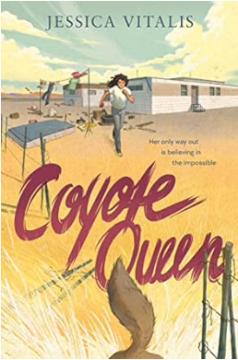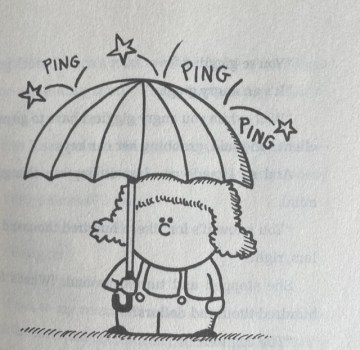This week I chatted with Jessica Vitalis about her new middle grade novel COYOTE QUEEN (Out 10/10—GreenwillowBooks).
I’ve always believed that writers dig deep into their souls to find the best stories. Jessica has done a brilliant job of turning her pain into art.
I’m excited for young readers to learn more about Fud’s ( and Jessica’s) emotional journey.
Let’s do this . . .
Please tell us about COYOTE QUEEN
Desperate to escape an abusive situation, twelve-year-old Fud enters a local beauty pageant hoping to win the prize money she and her mother need to leave. But an eerie connection to a local pack of coyotes causes strange changes to her body––her smell improves, she goes colorblind, and soon, she has to figure out how to win the pageant with a tail.
The story is so unique and fresh, how did you come up with this idea?
I originally set out to write a memoir, but I soon learned that life didn’t follow a convenient narrative arc, and as a new writer, I didn’t have the chops to pull off the story. I set the memoir aside and started writing fiction, but the idea of writing about a girl in a difficult situation wouldn’t leave me alone. I tried again, this time fictionalizing several elements of the story, but it didn’t really come together until I incorporated the coyotes that used to howl around our one-room cabin on the Wyoming/South Dakota border at night. Inspired by THE NEST (by Kenneth Oppel), I decided to add a speculative twist to the story using the coyotes as a metaphor for Fud’s longing to escape, and that’s when the story took on a life of its own.
What was the most difficult aspect of writing this book?
When I first set out to write a memoir, my goal was to tell my story. As I got older (and found a really good therapist!), I realized the real goal was to write a story that would help children in difficult situations. Letting go of my story while at the same time digging deeply into all the emotional baggage I needed to sort through in order to write Fud’s story was a process that took nearly two decades.
How do your life experiences impact the stories you tell?
My stories are all impacted by my life experiences. COYOTE QUEEN is the most obvious example since I used my difficult childhood to shine a light on the kids who might otherwise not have much of a voice in contemporary literature. But with every one of my books, I try to bring a unique perspective formed by having experienced a vast array of different socio-economic situations (a theme that always seems to crop up in my work). Regardless of the story, my mission is always to write enjoyable and thought-provoking books that cause readers to ask big questions about themselves and the world around them.
Do you have a favorite chapter in this book?
Oh, that’s a hard one! Letting Fud’s authentic self shine in the pageant was a lot of fun, but I also really love the scene that takes place after she gets home, when she has to come to terms with what’s happening to her body. I won’t say anything more for fear of giving something away, but I love how the scene straddles the line between reality and fantasy, leaving it up to the reader to decide what’s really happening.
What books did you like to read when you were growing up? Do those books influence your writing?
As a kid, I read every book I could get my hands on. That said, we were always on the move and the books were almost always from libraries, so I rarely read a book twice. My writing is probably more influenced by contemporary writers I admire such as Gary D. Schmidt, Erin Entrada Kelly, Tahereh Mafi, and Kate DiCamillo since I carefully studied their writing in my own (very long) journey toward publication.
When did you decide you wanted to become a writer and why children’s books?
Living with domestic violence as a kid, I learned that it was safer to make myself invisible, but I had a deep-seated longing to be seen and heard. That longing carried into adulthood, and it’s what compelled me to try to write a memoir. At the same time, I’d always loved writing, and since I was constantly reading picture books to my young children, I also wrote several PB manuscripts; every time I brought one to my critique group, they said it would make a fantastic first chapter in a middle grade novel. Since I hadn’t read one of those since middle school, I checked out KIT’S WILDERNESS (by David Almond) from the library, and I’ve never looked back!
What advice would you give twelve-year-old Jessica?
I would tell her that she’s stronger than she knows, and that as long as she continues working hard and believing in herself, she’ll do just fine. I would also tell her that the key to writing is to focus on the character’s emotional arc rather than the plot––something that took me years to learn!
What do you hope readers will take away from COYOTE QUEEN?
The sad reality is that one BILLION children each year experience abuse; I hope this book, and sharing my story, shows anyone struggling that there is hope for the future, and that it gives them the courage to ask for help. For readers who have never experienced domestic violence (or lived with poverty), I hope this story serves as a powerful tool for building empathy and raising awareness.
What are you working on now?
I’m so glad you asked––my next novel, a historical novel in verse, publishes in the fall of 2024, and it finally has a title! I can’t wait to share more details about UNSINKABLE CAYENNE with you in the coming weeks and months!
Thank you so much for visiting the MUF Blog, Jessica. Congratulations and best wishes on the release of COYOTE QUEEN!
JESSICA VITALIS is a Columbia MBA-wielding writer with Greenwillow / HarperCollins. She authored The Wolf’s Curse and The Rabbit’s Gift (which received two starred reviews and was named a Canadian Children’s Book Center Best Books for Kids and Teens 2023). Her next book, Coyote Queen, is a Junior Library Guild Gold Standard Selection and has already received a Kirkus starred review.
A novel in verse, Unsinkable Cayenne, comes out in 2024. Her work has been translated into three languages, and she was named a 2021 Canada Council of the Arts Grant Recipient and featured on CBCs Here and Now and CTVs Your Morning. Jessica lives in Ontario with her husband and two daughters but speaks at conferences, festivals, and schools all over North America.
To learn more about Jessica check out her website or follow her on social media.

 You’re in for an extra-special treat, Mixed-Up friends! Today, Stephan Pastis, the author/illustrator of the wildly popular and critically acclaimed New York Times bestselling Timmy Failure series—which was lauded by Kirkus as: “Wittier than the Wimpy Kid”—as well as the creator of the syndicated comic strip Pearls Before Swine, is here to chat about his latest illustrated MG novel,
You’re in for an extra-special treat, Mixed-Up friends! Today, Stephan Pastis, the author/illustrator of the wildly popular and critically acclaimed New York Times bestselling Timmy Failure series—which was lauded by Kirkus as: “Wittier than the Wimpy Kid”—as well as the creator of the syndicated comic strip Pearls Before Swine, is here to chat about his latest illustrated MG novel, 




















 k that monsters inspired by Cuban folklore contain unique or distinct characteristics compared to monsters common in the U.S. ?
k that monsters inspired by Cuban folklore contain unique or distinct characteristics compared to monsters common in the U.S. ?
 Why do you think spooky stories connect with middle grade readers?
Why do you think spooky stories connect with middle grade readers?
